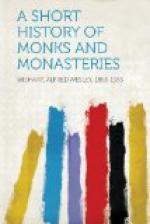lost their way and came to a farmhouse of the Benedictines.
It was nearly night and raining. They gently knocked,
and asked admittance for God’s sake. The
porter gazed on their patched robes and beggarly aspect
and supposed them to be mimics or despised persons.
The prior, pleased with the tidings, invited them in.
But instead of sportively performing, these two friars
insisted, with sedate countenances, that they were
men of God. Whereat the Benedictines in jealousy,
and displeased to be cheated out of their expected
fun, kicked and buffeted the two poor monks and turned
them out of doors. One young monk pitied them
and smuggled them into a hay-loft where we trust they
slept soundly and safe from the cold and rain.”
The two friars finally reached Oxford and were well
received by their Dominican brothers. Such was
the simple beginning of a brilliant career that was
profoundly to affect the course of English history.
Both at Cambridge and Oxford the monastic orders exercised
a remarkable influence. Traces of their labors
and power may still be seen in the names of the colleges,
and in the religious portions of the university discipline.
They built fine edifices and manned their schools
with the best teachers, so that they became great
rivals of the regular colleges which did not have the
funds necessary to compete with these wealthy beggars.
Another cause of their rapid progress was the exodus
of students from Paris to England. During the
quarrel at Paris, Henry III. of England offered many
inducements to the students, who left for England
in large numbers. Many of them were prejudiced
in favor of the friars, and they naturally drifted
to the monastic college. The secular clergy charged
the friars with inducing the college students to enter
the monasteries or to turn begging monks. The
pope, the king, and the parliament became involved
in the struggle, which grew more bitter as the years
passed. After a while Wyclif appeared, and when
he began his mighty attack upon the friars the joy
with which the professors viewed the struggle can be
appreciated.
The Decline of the Mendicants
The Mendicant friars won their fame by faithful and earnest labors. Men admired them because they identified themselves with the lowest of mankind and heroically devoted themselves to the poor and sick. These “sturdy beggars,” as Francis called his companions, were contrasted with the lazy, rich, and, too often, licentious monks of the other orders. Everywhere the friars were received with veneration and joy. The people sought burial in their rags, believing that, clothed in the garments of these holy beggars, they would enter paradise more speedily.




